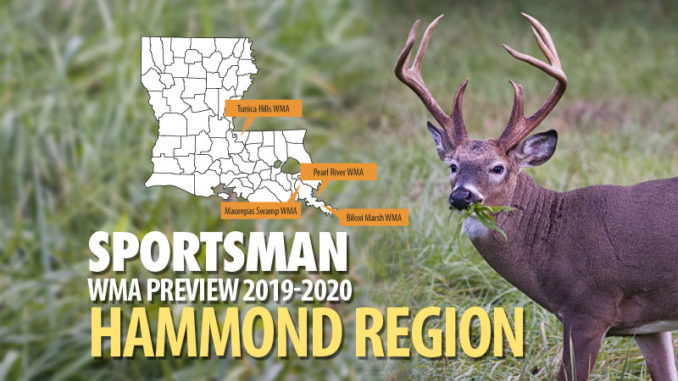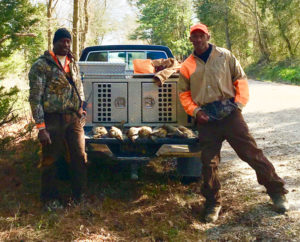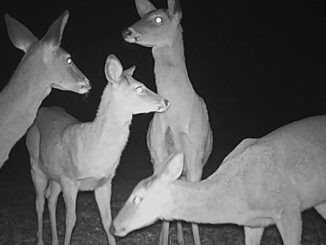
Long periods of flooding make for plenty of question marks for deer hunters on affected WMAs. But for ducks, the more water, the merrier. Here’s a survey of top public-hunting areas in Louisiana
With more than a million acres enrolled in the Louisiana Department of Wildlife and Fisheries’ Wildlife Management Area program, hunters in the Sportsman’s Paradise really do have a paradise of available outdoors opportunities.
As the opening of 2019-20 hunting seasons approach, here is a look at what public lands around the state have to offer.
Waterfowl
Shotguns roar long and loud when duck hunting is in season on the Biloxi Marsh WMA, and many of the shots come from out-of-staters who know how good the waterfowl hunting can be on the 35,644-acre area in St. Bernard Parish.
“Biloxi is one of the premier duck-hunting destinations in southeast Louisiana,” said biologist Jillian Day of the LDWF, who is stationed in Hammond. “People will travel great distances to come down here. I’ve had several phone calls from people out of state that are asking about it and want to know what the rules and regulations are.”
Day, a 10-year LWDF veteran, said the draw for ducks — provided they come down — and duck hunters is “plenty of waterfowl habitat.” Biloxi Marsh WMA has numerous bayous, sloughs and potholes that waterfowl utilize.
Also, she said, the area is a low, brackish to saline marsh with widgeon grass being the main submerged aquatic vegetation. And as of late July, duck food development and habitat conditions are promising at Biloxi and the other WMAs in the Hammond Region.
“We had only minor impacts from (tropical storm/hurricane) Barry,” Day said. “Maurepas Swamp, Manchac, Joyce and Pearl River WMAs saw high water associated with storm surge, but that receded fairly quickly after the storm made landfall. A few trees were blown down across the region, but nothing significant.
Day advised duck hunters to consult the 2019-20 hunting pamphlet for legal shooting hours on Biloxi WMA and all areas in the Hammond Region.
A few other WMAs in the region offer fair to good duck hunting, depending on the weather and duck migration.
Pearl River WMA is another popular duck-hunting destination in southeast Louisiana. The central part features cypress/tupelo swamps, and the upper region has mixed pine hardwoods and bottomland hardwoods, Last season, based on self-clearing permits, 1,473 ducks were harvested in 2,160 hunter efforts.

Day said the area routinely has high waterfowl harvest numbers because of its abundance of wetland habitat. That enhances its popularity. Plus, the area is near New Orleans and Northshore.
Manchac WMA is one of the better waterfowl hunting areas in the Lake Pontchartrain basin, Day said. The section known as “The Prairie” is an open freshwater pond with broken marsh. A large section of The Prairie is a limited-access area (paddle-in only) and has plenty of submerged aquatic vegetation.
Deer
If hunters want big deer, meet the challenge of hunting Maurepas Swamp WMA, which sprawls across Ascension, Livingston, St. John the Baptist, St. James and Tangipahoa parishes. Access to prime areas is difficult, to put it mildly.
“That makes it tougher but it also makes it one of the benefits,” Day said. “You’re talking about 120,000 acres you can hunt on. That spreads them out. Anybody who wants to hunt the area can get in a boat. That’s one of the things about it.”
For example, she said, if a deer hunter sees a boat in an area, he or she can move down or up the bayou, and nobody will walk in on him or her because it’s an inundated cypress/tupelo swamp.
The deer herd thrives in the watery world of Maurepas Swamp WMA. They move agilely and stealthily without problem because their hooves are shaped a little different than other deer located on higher ground.
“They’re a little wider and a little shorter,” she said.
There are high ridges available during high-water periods.
The swampy environment also benefits the herd because deer can get away from pressure.
“They flourish out there. They’re tough animals, for sure. They make it,” she said.
Last season, 143 deer were harvested in 2,808 hunter efforts, based on self-clearing permits.
That WMA’s deer-hunting success was followed by Tunica Hills WMA, 81 deer in 1,571 hunter efforts, and Pearl River WMA, 56 deer in 1,571 hunter efforts.
Day said that Tunica Hills WMA, which has one of the more fertile, productive habitats in the region, will have a change in the season structure for the primitive-weapons season in an effort to gain more biological data from the area’s deer herd.
Rabbit/Squirrel
The Maurepas Swamp WMA is also a consistent producer of squirrels and rabbits on its more than 120,000 acres.
Most of the area is accessible by boat only. Still, it routinely ranks first in rabbit and squirrel harvests in the Hammond Region, Day reported.
Last season, 89 rabbits were harvested in 487 hunter efforts, and 1,611 squirrels were bagged in 1,111 hunter efforts, according to self-clearing permits.
“This WMA is a consistent producer of squirrels and we expect the same for the upcoming season,” she said.
The region’s top squirrel harvest last season, however, was recorded on Pearl River WMA, where 1,689 squirrels were taken in 1,592 hunter efforts.
“As the understory on the northern third of the WMA continues to open up, there is still plenty of understory and early successional habitat. There are plenty of squirrels in the area and we expect to have another successful season,” Day said
At Tunica Hills WMA, 332 squirrels were harvested in 320 hunter efforts last season. The area has an abundance of mature oaks and other mast-producing trees that offer prime squirrel habitat.
HAMMOND REGION
PROS
Tunica Hills WMA’s south tract is the site of timber stand improvement, which should put sunlight on the ground to enhance browse conditions for deer. Some approved timber prescription has been marked, and harvest opportunities will be explored.
Pearl River WMA is one area where prolonged flooding will have a positive effect — mast-crop improvement. When trees are stressed, they put more effort into their mast production to ensure species survival.
Manchac WMA is benefitting from biological and chemical control measures to reduce hyacinths and giant salvinia. It’s a never-ending battle, and early surveys show invasive plant coverage is average, a big win for managers.
Lake Ramsey WMA should benefit from prescribed burns by The Nature Conservancy this year. The prescribed burn regimen is necessary for the habitat type to continue to be productive.
CONS
Pearl River WMA has been plagued by prolonged flooding the past several months, water conditions that forced several closures on the area at different times. Browse availability may be impacted. Recruitment may be reduced in the long term.
Tunica Hills WMA’s timber-stand improvements were delayed due to the closure of the Port Hudson Mill. While additional efforts for timbers sales are being explored, LDWF staffers have conducted small scale TSI work to keep early successional habitat on the ground. Also, the area’s feral hog population is increasing.
Check out the other regions below:
Lafayette Region
Lake Charles Region
Minden Region
Monroe Region
Pineville Region
Coastal & Non-Game Resources Division Region


